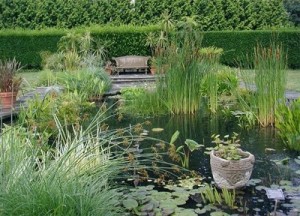





Although the finished result should look completely natural, a wildlife garden requires a great deal of thought in the planning stages in order to get the balance of planting just right. You will need to consider whether you are trying to recreate a specific type of habitat in your garden, or in one part of it, or whether you just want to provide the conditions throughout the garden for wildlife to thrive.
 Any garden could be considered as a wildlife garden of sorts — after all, no garden could claim to be insect free, and all gardeners welcome the invaluable earthworm. The difference is that in a true wildlife garden people actually wish to encourage insects, even if some of them may cause damage to the occasional flower, and will be happy to see wild poppies coming up in the middle of flower beds and borders.
Any garden could be considered as a wildlife garden of sorts — after all, no garden could claim to be insect free, and all gardeners welcome the invaluable earthworm. The difference is that in a true wildlife garden people actually wish to encourage insects, even if some of them may cause damage to the occasional flower, and will be happy to see wild poppies coming up in the middle of flower beds and borders.
Why on earth would any gardener want a wildlife garden? After all, most gardeners spend a great deal of time, effort and money keeping wildlife such as rabbits, pigeons and cabbage-white caterpillars out of the garden. Some gardeners would also include bullfinches, squirrels, moles, greenfly, blackfly, codlin moth, eelworms and even badgers and foxes in the list of unwanted guests.
In the past, gardeners did not consider wildlife as something to be welcomed into the garden, and tentative gestures at growing wild flowers, including naturalizing daffodils in the lawn or planting a wildflower meadow in an attempt to re-create a half-remembered idyll of childhood hayfields rich in a colourful tapestry of cowslips, pink tampion and ox-eye daisies, were the exception to the rule.
One of the major catalysts for change was the publication of the book Silent Spring by Rachel Carson in the early 1960s. This book drew attention to the damage farmers were doing to wildlife through their increasing use of chemicals. It also enumerated the reduction of habitats by increased mechanization, including the removal of hedgerows to increase the size of fields. Alarm bells rang in some quarters, and an interest in the environment, and what we were doing to it, gradually started to emerge. Now there is a global awareness of the importance of biodiversity, and efforts are being made, both nationally and internationally, to try to protect all native fauna and flora.
Monoculture is the growing of a single plant in one area, like a field of wheat or an orchard of apple trees, which makes for easier management but has the potential to lead to shortages of individual soil nutrients or to the build-up of pests and diseases that are specific to the plant grown.
Most modern farming practices are monocultural, with the result that constant spraying with chemicals is needed to keep the crops free of pests, diseases and weeds. It is this arguably excessive use of sprays that has resulted in the loss of many native plants and animals throughout much of the world, not just in the West. Like farming, gardening can also be monocultural. Rose beds, closely mown lawns and plots of cabbages are all monocultural and depend on chemical controls to produce an unblemished result.
At the opposite end of the scale is biodiversity, whereby farmers and gardeners aim for as wide a variety of plant and animal species as possible within any given area. In the past, much time was spent studying plants and animals in their native habitats, but, with the declining numbers of some wildlife species and the reduction of their habitats, ecologists are now looking to gardens as potential homes for some of these threatened plants and animals.
The aim for a gardener who is interested in attracting wildlife is probably somewhere between the extremes of the unkempt bramble patch and the perfectly maintained garden. Such a gardener may want to include an element of monoculture, perhaps a lawn or a rose bed or two, but will also encourage a wider range of birds, insects, animals and wild plants within the garden as a whole.
Getting this balance of elements right is important: you want to have a garden that has something for all the members of the household to enjoy, but you also want to create interesting habitats where a wide range of native plants and animals can thrive.
Copyright © www.100flowers.win Botanic Garden All Rights Reserved